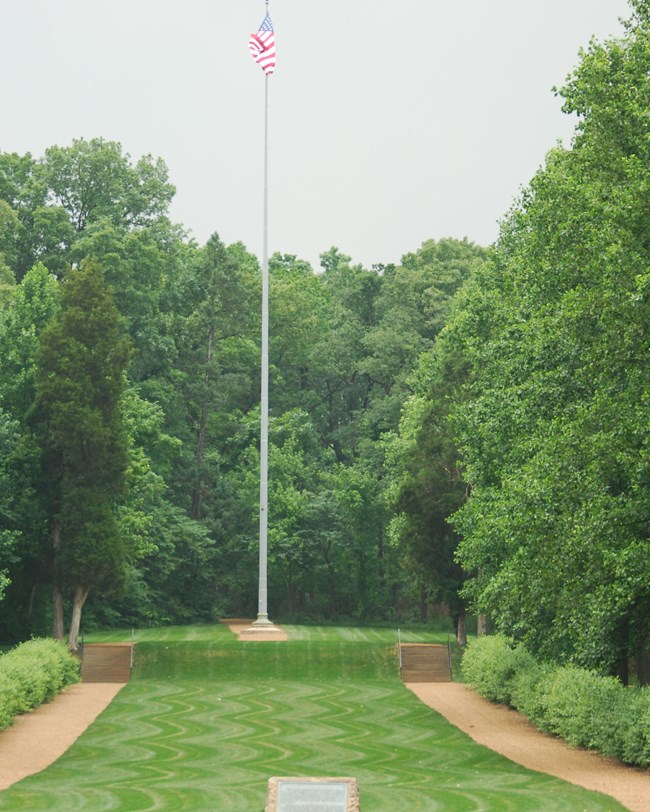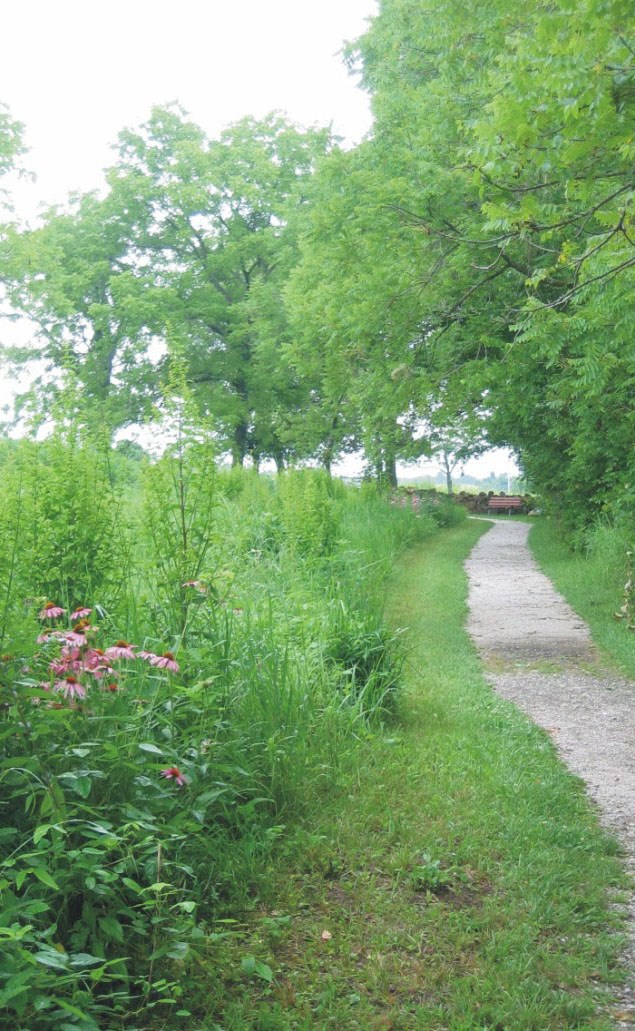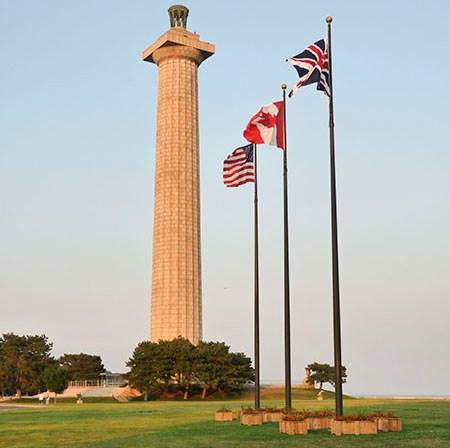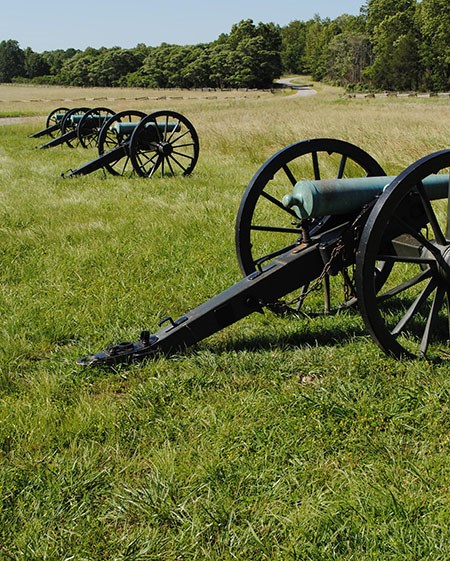Last updated: February 13, 2024
Article
Commemorative Cultural Landscapes of the Midwest
Behind the Scenes: Places of Remembrance
Humans have long used ceremonies and the built environment to honor a person or event. A commemorative designation or constructed feature, such as a memorial, can be a place of personal connection, healing, respect, and remembrance. It can also help to perpetuate memory into the future.
NPS
The commemorative sites cared for by the National Park Service and partners may range from small burial plots once associated with family farmsteads to large designed landscapes, architectural monuments, and memorial buildings. Some sites existed before becoming NPS units and were constructed by a state, city, or local organization. At others, the memorial features and operations were primary developed by the NPS. In still other cases, the NPS or a partner commissioned the design and construction of a commemorative work, such as the Gateway Arch or the Oklahoma City National Memorial.
CL 101
Commemorative Landscapes of the Midwest
Here are just a few examples of commemorative landscapes in the Midwest Region along with their treatment documents, including the recently published Cultural Landscape Treatment Plan and Environmental Assessment for Perry's Victory and International Peace Memorial (2018).
A Formal Design
The site includes a memorial at the site of the Lincoln cabin and a memorial building integrated into a formal landscape. The landscape design includes sculptured panels, a memorial court with gravel paths and stone benches, and a tree-lined walk called an allee that creates a visual connection between the prominent flagpole and the memorial plaza. Just beyond the end of the formal walk, a grave marker in a pioneer cemetery prominently displays the final resting place of Lincoln’s mother, Nancy Hanks Lincoln, who died in 1818. The designed landscape incorporates the commemorative elements in the memorial landscape.
Read More:
A Noble Avenue: Lincoln Boyhood National Memorial Cultural Landscape Report
The Evolution of a Sanctified Landscape: A Historic Resource Study of the Lincoln Boyhood National Memorial

NPS
- Cultural Landscape Period of Significance: 1927-1945
- Designed Landscape: The design and construction process brought together some of the more significant figures in state park development, including Frederick Law Olmsted, Jr. and Richard Lieber.
- Location: Spencer County, Indiana
- Commemorates: Abraham Lincoln and Nancy Hanks Lincoln. Exemplifies cooperative projects completed under federal Depression-era work programs.
Inspired by Nature
The experience of the landscape invites reflection of Carver’s early years. Visitors start at the site of the cabin where Carver was born, where a reconstructed cabin now stands. An interpretive trail leads past restored native grassland, which has replaced agricultural fields once farmed by the Carver family. The trail continues past the Moses and Susan Carver house (which was moved to its current location) and to the Carver family cemetery. The trail design also includes sculpture and quotes, and it culminates in a small plaza with a bust and voice recording of the famous scientist.
Intentionally informal and experiential, the cultural landscape honors George Washington Carver by inviting visitors to walk a path similar to the path he might have followed through this landscape of his youth. This experience also aims to invoke a curiosity in the natural world to inspire the next generation of naturalists and scientists. Today, the management of the cultural landscape follows the recommendations in the cultural landscape report.
Read more:
George Washington Carver National Monument: Cultural Landscape Report and Environmental Assessment

NPS
- Cultural Landscape Period of Significance: 1865–1876, the years in which Carver lived at the site, and 1943-1960, the commemorative era in which the landscape was dedicated and developed to memorialize the accomplishments of George Washington Carver, concluding with dedication of the Mission 66 visitor center.
- Designed Landscape: Boy Carver statue was designed and cast by Roberta Amendola. Many of the features were constructed between 1953 and 1960 through the NPS Mission 66 initiative.
- Location: Diamond, Missouri
- Commemorates: George Washington Carver. As his birthplace and boyhood home, the landscape represents where he spent his formative years and the place that set him on the path to becoming one of this nation’s most distinguished scientists, educators, and humanitarians.
Continuing Stewardship
At Perry's Victory, the horizontal planes of open lawn on the memorial plaza lend an open character to the historic core and emphasize the vertical column. The symmetry and spatial organization of the landscape remain intact.
Congress transferred the operation of the site to the National Park Service in 1936, providing for the care and interpretation of the site. The first cultural landscape report was prepared in 1994. To better accommodate the needs of the park, the Cultural Landscape Treatment Plan and Environmental Assessment for Perry's Victory and International Peace Memorial was completed in 2018. Implementation of this treatment plan will guide the care and provide for the on-going site needs in this challenging location.
Read more:
Cultural Landscape Treatment Plan and Environmental Assessment for Perry's Victory and International Peace Memorial

NPS
- Cultural Landscape Period of Significance: 1911-1963. In addition to its commemorative proporties, the site is significant for its association to social history, politics, government, and architecture and engineering.
- Designed Landscape: Joseph Freelander
- Location: Put-in Bay, Ohio
- Commemorates: War of 1812 Battle of Lake Erie on September 10, 1813 under leadership of Commodore Oliver Hazard Perry. Symbol of peace between the Great Britain, Canada, and the United States.
Layers of Memory
The 1963 master plan articulated several objectives that remain relevant today. These include restoring and maintaining fields and woodlands as they were during the Civil War battle in 1862 and preserving Elkhorn Tavern, foundations of Leetown buildings and structures, trenches, and other appurtenances of 1862. In addition, the 1963 master plan aimed to establish and maintain the system of historic trace roads that existed in 1862. Development of new facilities was restricted to ensure the preservation of the battlefield.
However, the park is not only significant for a famous military conflict. Another tragic event touched this landscape prior to the Civil War, when the Trail of Tears (1835-1839) followed the park’s Telegraph Road from Missouri to Arkansas and camped in Ruddick’s Field.
Read more:
Cultural Landscape Report and Environmental Assessment for Pea Ridge National Military Park

NPS
- Cultural Landscape Period of Significance: 1862-1865, 1956-1963
- Designated: Pea Ridge National Military Park was established on July 20, 1956. In the 1960s, as part of the Mission 66 program, the NPS completed facilities for the park including the visitor center, Tour Road, overlooks, and interpretive stops.
- Location: Pea Ridge, Arkansas
- Commemorates: Battle of Pea Ridge (March 7 and 8, 1862). It preserves the site of the battle, the largest Civil War engagement west of the Mississippi River. The park’s resources include archeological sites, historic sites, structures, collections and cultural landscape features associated with the battle and the agrarian community once found at Pea Ridge.
Tags
- george washington carver national monument
- lincoln boyhood national memorial
- pea ridge national military park
- perry's victory & international peace memorial
- cultural landscape
- mwr
- clr
- cultural landscape report
- perrys victory and international peace memorial
- george washington carver
- abraham lincoln
- civil war
- war of 1812
- trail of tears
- commemorative landscape
- memorial
- featured article
- landscape architecture
- midwest
- midwest nps





